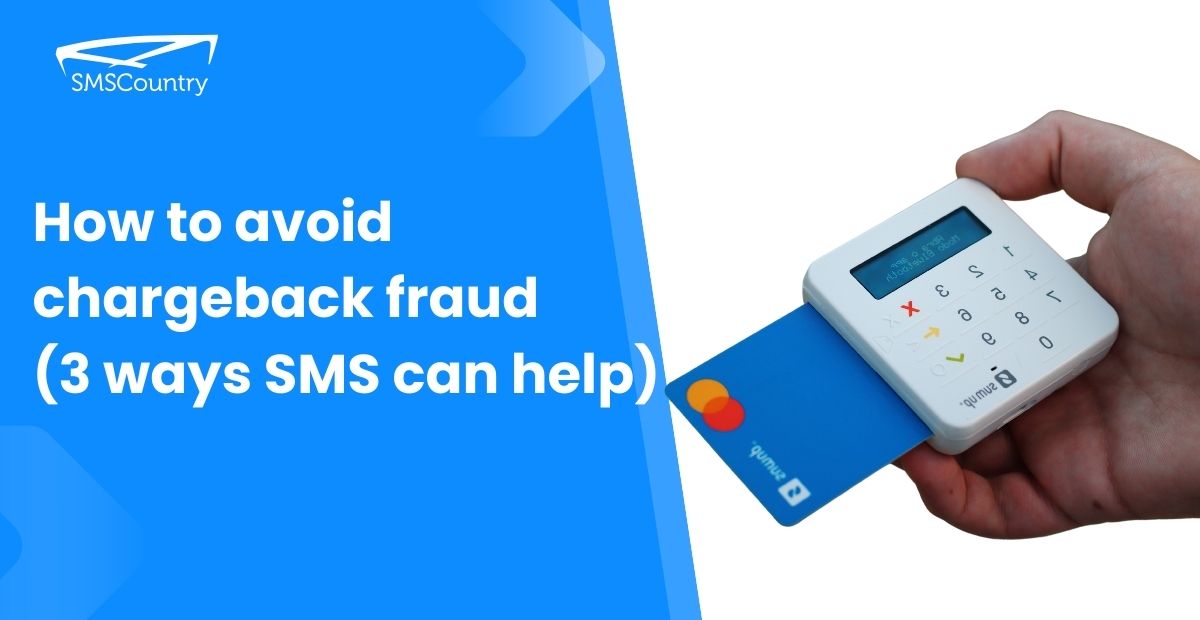Do you get that sinking feeling when you get a chargeback notification? It’s not only frustrating, but it also affects your business’s bottom line.
Sadly, chargeback fraud affects merchants of all sizes.
So, how do you combat it?
In this article, we’ll discover the tools and best practices you can use in your chargeback fraud management and fight.
But we won’t stop there – we’ll also explore how SMS is a valuable tool in your chargeback fraud prevention arsenal.
By the end of this article, you’ll be able to protect your business from chargeback fraud.
So, if you’re tired of the headaches, read on.
| SMSCountry is the best bulk SMS service to secure customers from fraud with fast and secure OTP and alert messages. Learn more about our SMS services. Get started or schedule a demo. |
What is chargeback fraud?
Chargeback fraud, or as some people call it, “friendly fraud,” happens like this. Imagine a customer uses their credit card to buy something from your online store. All seems fine.
But, after they’ve received their order, they turn around and ask their bank to reverse the charge. Sneaky.
Chargeback fraud is when someone pulls this trick, pretending they didn’t authorise a purchase. Or claiming not to receive what they paid for while already enjoying it.
They get to eat their cake and still have it but at the expense of your business.
You lose the money from the purchase and the product or service you provided. Talk about an unfair situation.

How do scammers perform chargeback frauds?
You might be thinking, “How is this even possible?”
There are different types of chargeback fraud and ways they go about it. Here is how they get to trick you:
- Step 1: The scammer sets their sights on your online store. They browse through your products. They’re looking for something they want without the intention of paying for it.
- Step 2: Once they find their target, the scammer purchases it using their credit card. Everything seems normal at this point.
- Step 3: After receiving the product, the scammer starts plotting their deceitful move. They know they can use the chargeback option as their secret weapon.
- Step 4: The scammer contacts their credit card company or bank. They claim they didn’t make the transaction or the product never arrived. They make up a story and play the victim.
- Step 5: The bank, wanting to protect their customer, initiates a chargeback. This means they reverse the transaction and refund the scammer’s money. Of course, the bank takes the money back from you.
The scammer gets to keep both the product they received and the refunded money. They’ve managed to score a free item by tricking the system. You lose the money from the sale and the product you shipped.
To add insult to injury, some scammers resell the product they got for free. That way, they make a profit off their deceitful actions.
Here’s hwo the process looks like.

Now, you know what chargeback frauds are. But have you thought of its impact on your business?
The next section will enlighten you on this.
How can chargeback frauds impact your business?
Let’s look at some ways in which chargebacks affect your business.
1. Loss of revenue
When a chargeback happens, you watch your hard-earned cash vanish. Your revenues take a real hit, and it can be a significant dent in your expected earnings.
Think about it this way. You put in all the effort, time, and resources to provide a product or service to your customers. You’re expecting that sweet payment to come through, but a chargeback fraud hits you like a ton of bricks. That money you were counting on is suddenly gone, leaving you in a tough spot.
Not only do you lose the actual money from the sale, but you also lose the product or service you provided. It’s a double whammy that can throw your business off balance and make it harder to grow and thrive.
Chargeback fraud messes with your cash flow and ability to invest in your business. You can see it as a game of catch, where someone keeps throwing your hard-earned cash far away.
2. Additional admin costs
Did you think losing money and products is all there is to it?
No, you can even lose more. Disputing chargebacks can be a real headache on your workforce and resources.
First, you’d need to gather all the evidence to support your case. You dig through your records, emails, and customer interactions.
You’re looking for proof that the purchase was legitimate and the customer got what they paid for. You become a detective, searching for clues in a messy room.
Then comes the paperwork. You have to prepare a detailed response to the chargeback. You’ll explain your side of the story and provide your collected evidence.
Next, you must report and submit all the necessary documentation to the relevant parties. For example, the credit card company or the bank.
But wait, the saga isn’t over yet. Now, you have to wait. And waiting can feel like an eternity. You anxiously check your emails and mailbox, hoping for a positive response.
During this whole process, your workforce and resources get diverted.
You or your team members spend valuable time and energy dealing with chargeback disputes. You could’ve used that energy to grow your business or provide better customer service.
After all the efforts, the bank might not return your money.
3. Risk of account suspension
Another danger of chargebacks is getting your account suspended by the banks.
Here’s the problem: banks keep a close eye on chargeback ratios. They want to ensure you are playing fairly and not racking up too many reversals.
When the banks notice many chargebacks from your account, it raises a red flag. They start thinking, “Hmm, something fishy might be happening here.”
They might question the legitimacy of your business. Or think that you aren’t providing satisfactory products or services.
And guess what? They can suspend your account if they’re unsatisfied with what they find.
Account suspension stops your ability to accept payments. No more transactions, no more money flowing in.
Not only does it hurt your cash flow, but it also damages your reputation. When customers see that your account is on suspension, they may lose trust in your business.
Now that you know how chargebacks affect your business, how do you prevent them from harming your business?
| Want to send fast and secure OTP and transactional messages to secure your customers on WhatsApp? Get our WhatsApp messaging solution Today! |
How do you avoid chargeback fraud? 7 best practices to prevent chargebacks
Here are seven measures you can put in place to prevent chargeback fraud.
1. Verify customer identities
Verifying customer identities helps in preventing chargeback fraud. When you verify customer identities, you can catch sneaky fraudsters.
By confirming that the person buying is who they claim to be, you can weed out those who are up to no good.
Not only does verifying customer identities help you catch the fraudsters, but it also builds trust. It’s like giving your customers a reassuring nod and a warm smile.
When you show that you take their security seriously, you create a safe environment for them to buy from you.
You can use various software and services to verify customer identities to prevent chargeback. Here are some options available:
- Identity verification software: Use software that uses intelligent computer programs to check customers’ identities.
- Document verification: Use services that let customers show their essential documents. For example, passports or driver’s licence. This way, they can prove who they are without showing the paper documents.
- Biometric authentication: Using tech like fingerprints or face recognition to confirm identities. Customers simply use their unique features to prove their identities.
- Address verification systems: The tools check if the address matches official records. They make sure customers are telling the truth about where they live.
- Two-factor authentication: Adds an added layer of security. This means that customers need to prove their identity twice. They have to enter a unique code sent to their phone after entering their password. The most popular 2fa system is the use of OTP.
- Fraud detection services: Help track suspicious activity and catch those trying to cheat the system. They look at how people act and what they’re doing to spot anything fishy.
- KYC (Know Your Customer) solutions: These are tools you can use to ensure you know your customers. They check if the customers are following the rules set by the government.
2. Use Address Verification Service (AVS)
Let’s say your customer buys something online from you and enters their address for payment. The AVS service checks if the address they gave matches the one connected to their credit card.
Here’s how it works:
- Your customers enter their addresses when they buy from you online.
- The online system sends their address to the AVS service securely.
- The AVS service checks with the credit card company’s database. It compares their address with the one they have on file.
- The AVS service gets a response code from the credit card company, telling if their address matches.
- If your address matches, the AVS service gives a positive response code, showing it’s a good match.
- The AVS service gives a harmful response code if the addresses don’t match.
Remember, the AVS service doesn’t guarantee that the transaction is legit. Neither does it tell you if the person using the card is the actual owner. It only checks if the address matches for security reasons.
3. Implement a secure checkout process with SSL
A secure SSL-encrypted checkout helps you protect your customers’ info from scammers. Let’s explain how it works:
SSL encryption is like a unique lock on a box to keep the money and address information secure. It’s a way to ensure only the right people can open the box and see what’s inside.
When customers give you their info, SSL encryption turns it into a secret code. Only you and you see what’s inside.
This secret code travels to a computer server, where the info is stored safely.
Scammers who try to steal the info get stuck because they can’t understand the secret code. It’s like trying to read a message that’s all mixed up and makes no sense.
With SSL encryption, you can protect your customers’ names and addresses. You can also keep their payment details safe as well. No one can steal their credit card info to purchase from your shop. This may lead to them asking for a chargeback since they didn’t make the purchase.
4. Offer excellent customer service
Excellent customer service means taking good care of your customers. It also involves listening to their needs and going to lengths to solve their problems.
But did you know it can help prevent chargeback fraud? Here’s how it works:
- Building trust: When you give excellent customer service, you build trust with your customers. They feel confident that if they have any problems, you’ll be there to help them. This trust makes it less likely for customers to ask for a chargeback immediately.
- Quick communication: When your responses are timely, you create an open line of communication. Customers are more likely to contact you directly to solve any issues. With this, they won’t go straight to their credit card company for a chargeback.
- Solving problems: If customers have trouble with their purchases, fix the problem quickly and make them happy. When you find a fair solution to their concerns, you show that you care about their satisfaction. This makes it less likely for them to ask for a chargeback.
- Refunds or exchanges: Customers might want to return goods and get their money back. If you have clear policies for refunds or exchanges, it shows that you want to please your customers. When customers know they have options to fix any issues, they are less likely to ask for a chargeback.
- Keeping customers informed: Give transparent and honest info about your products, services, and policies. This helps customers make smart choices when they buy something. When customers know what to expect, it reduces issues that could lead to chargebacks.
You create a positive experience for your customers by providing excellent customer service. You build trust, solve problems, and give them the help they need.
Happy customers are less likely to defraud you because they know you care about them.
5. Have a clear return policy
You need a clear set of rules that everyone understands when returning products. Let’s see why it helps prevent chargeback fraud:
- Transparency: A clear return policy shows that you are honest. They know what to expect if they want to return something.
- Customer awareness: Your customers learn the rules and timeframes for returns. This helps prevent misunderstandings that can lead to chargebacks.
- Customer satisfaction: A clear return policy shows you care about your customers. When they know they can return a product, they are less likely to ask for chargebacks out of frustration.
- Dispute resolution: A clear return policy provides a structured way to solve problems. Customers can follow the guidelines to resolve issues instead of asking for chargebacks.
- Reducing confusion: Clarity in your return policy prevents confusion. Customers who know the return rules are less likely to request chargebacks.
6. File a dispute with compelling evidence
Let’s say someone unfairly took your money through chargeback fraud. You can fight back by filing a dispute. Here’s what you need to do:
- Gather evidence: Collect any proof you have to support your case. This could be order details, shipping info, or messages with the customer.
- Make your case: Explain why you believe the chargeback is unfair. Use facts and evidence to support your argument and show that you’re right.
- Contact your payment processor: Contact the company handling your payments. Tell them about the chargeback. They’ll guide you through the dispute process and tell you what they need from you.
- Show your evidence: Share your collected evidence with your payment processor. This could be receipts, tracking numbers, or screenshots. Use them to support your side of the story.
- Cooperate and communicate: Stay in touch with your payment processor and answer their questions. It’s essential to communicate clearly and work together to strengthen your case.
- Wait for a decision: The payment processor will review all the evidence and make a decision. If your case is strong, you have a good chance of getting your money back.
By filing a dispute, you’re standing up for yourself and telling your story. Remember, act fast and provide strong evidence to support your case.
7. Set up SMS alerts for chargebacks
By using SMS alerts, you can proactively spot and deal with chargeback issues.
Now, let’s discover how SMS alerts can help prevent chargebacks.
| See the top bulk SMS service providers to send transactional and alert SMS. Check out the top OTP service providers to send fast and secure OTPs. |
How do SMS alerts help prevent chargebacks?
We all know that SMS is the real deal when sending alerts and notifications. Let’s see some incredible superpowers SMS has to nip chargebacks in the bud.
Real-time fraud alerts
Using SMS or text messages on your phone can help you fight fraud.
Here’s how:
- Quick notifications: When you set up SMS alerts, your phone gets instant messages whenever a transaction happens.
- Spotting fraud alerts: These SMS alerts act as your watchdogs. They let you know if something suspicious is going on with a transaction. For example, if there’s a strange purchase or someone spends a lot of money, you’ll get an alert immediately.
- Taking action fast: Once you receive a fraud alert, act on it. It’s like being a detective on the case. Contact the customer via SMS or check the transaction to ensure everything is fine.
- Talking to customers: SMS alerts let you speak to customers immediately. You can text them to confirm their purchase or ask for more information. This helps you check if the transaction is authentic and address any worries.
- Stopping fraud in its tracks: By using SMS alerts, you stay ahead of the fraudsters. It’s like having your secret weapon against fraud. You take action to stop fraud and keep your business safe.

Two-factor authentication
Two-factor authentication using SMS is simply adding an extra layer of security.
It makes it harder for unauthorised people to get in. This is because there are two verification steps instead of one.
Even if someone gets your customer’s password or PIN, they can’t access their phone to receive the code. This reduces the risk of unauthorised transactions and chargebacks.
Only real customers can make transactions, preventing fraudsters from using stolen information.
Customer communication
SMS is a helpful tool that you can use to talk to customers and solve problems quickly.
Here’s why it’s important:
- Instant and direct: SMS lets you message customers right away. It’s like sending a quick message to their phone, and they can respond immediately.
- Solve problems fast: With SMS, you can quickly fix customer issues and disagreements. It stops problems from getting worse and helps prevent chargebacks.
- Personal and friendly: SMS adds a personal touch to customer conversations. It’s like talking to a friend. This friendly approach helps build trust and make customers happy.
- Updates in real-time: SMS lets you send important updates and info instantly. It keeps customers informed and lowers the chance of misunderstandings or fights.
- Being proactive: With SMS, you can lead in fixing problems. It’s like being one step ahead. By reaching out and solving customers’ concerns, you can stop chargebacks.
- Keep a record: You can save SMS chats as proof of conversations between you and customers. This can be useful if there’s a disagreement or chargeback. It shows what you said and how you tried to fix things.
Empower your business to prevent chargeback fraud with SMSCountry
In the fight against chargeback fraud, being ahead is super important. That’s where instant alerts via SMS come in. They help you catch fraudsters in the act and stop them in their tracks.
SMSCountry is a top SMS provider that can help. You can use our OTP SMS services for 2FA as well as for setting up fast and secure alerts.
Don’t wait for fraud to hurt your business. Schedule a free demo with SMSCountry to see how SMS alerts can keep you safe.
FAQs
How is chargeback fraud different from a legitimate chargeback?
Chargeback fraud happens when someone tries to cheat the system. They try getting a refund and keeping what they bought simultaneously. But not all chargebacks are fraud. Customers have real problems. For example, someone uses their card without permission or is unhappy with what they bought. Those cases of chargeback are legitimate and not fraud.
What are some common types of chargeback fraud?
We have the friendly fraud, where the buyer says they didn’t get what they bought even though they did. Another is identity theft. Someone steals card info to make unauthorised purchases. Then the real owners of the credit cards use chargebacks to get refunds.
How do fraudsters obtain credit card information to commit chargeback fraud?
They send fake emails to trick people into giving their details or stealing info from websites. It’s called phishing. They can also steal card info during transactions.
Who is responsible for chargeback fraud?
Fraudsters who do chargeback fraud are the ones who choose to defraud. But businesses also have a responsibility to take action and prevent fraud. They should put in place safety measures to secure transactions.
Can chargeback fraud be prevented?
Chargeback fraud is hard to stop completely. But you can do things to mitigate it. You can use software tools that help you catch fraudsters. You can also check if customers are who they say they are, just like asking for a secret code to make sure it’s them.
What are some warning signs of chargeback fraud?
Some signs of chargeback fraud are big orders and rush shipping requests. There are also repeated purchases of the same item and wrong addresses.
How long does it take to resolve a chargeback fraud dispute?
Resolving a chargeback fraud dispute takes time. It can vary from a few weeks to a few months. It all depends on how complicated the case is, how fast everyone responds, and the rules set by the card company.
What are the consequences of chargeback fraud for merchants?
Merchants may lose money because they have to give refunds and pay fees. It can also make their business look bad and make payment companies keep a closer eye on them. Sometimes, it could even lead to problems with their account or make them stop doing business.
Is there a way to dispute a chargeback fraud claim?
If a merchant believes a chargeback claim is unfair, they have the right to fight back. They can show evidence for their side. They can explain their case to the payment company or the card issuer to contest the unfair chargeback.




